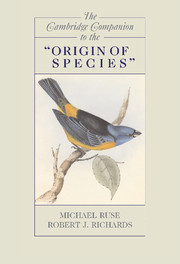Book contents
- Frontmatter
- Foreword
- Introduction
- 1 The Origin of the Origin
- 2 Darwin’s Analogy between Artificial and Natural Selection in the Origin of Species
- 3 Variation and Inheritance
- 4 Darwin’s Theory of Natural Selection and Its Moral Purpose
- 5 Originating Species: Darwin on the Species Problem
- 6 Darwin’s Keystone: The Principle of Divergence
- 7 Darwin’s Difficulties
- 8 Darwin’s Geology and Perspective on the Fossil Record
- 9 Geographical Distribution in the Origin of Species
- 10 Classification in Darwin’s Origin
- 11 Embryology and Morphology
- 12 Darwin’s Botany in the Origin of Species
- 13 The Rhetoric of the Origin of Species
- 14 “Laws impressed on matter by the Creator”? The Origin and the Question of Religion
- 15 Lineal Descendants: The Origin’s Literary Progeny
- 16 The Origin and Political Thought: From Liberalism to Marxism
- 17 The Origin and Philosophy
- 18 The Origin of Species as a Book
- Bibliography
- Index
11 - Embryology and Morphology
Published online by Cambridge University Press: 28 January 2009
- Frontmatter
- Foreword
- Introduction
- 1 The Origin of the Origin
- 2 Darwin’s Analogy between Artificial and Natural Selection in the Origin of Species
- 3 Variation and Inheritance
- 4 Darwin’s Theory of Natural Selection and Its Moral Purpose
- 5 Originating Species: Darwin on the Species Problem
- 6 Darwin’s Keystone: The Principle of Divergence
- 7 Darwin’s Difficulties
- 8 Darwin’s Geology and Perspective on the Fossil Record
- 9 Geographical Distribution in the Origin of Species
- 10 Classification in Darwin’s Origin
- 11 Embryology and Morphology
- 12 Darwin’s Botany in the Origin of Species
- 13 The Rhetoric of the Origin of Species
- 14 “Laws impressed on matter by the Creator”? The Origin and the Question of Religion
- 15 Lineal Descendants: The Origin’s Literary Progeny
- 16 The Origin and Political Thought: From Liberalism to Marxism
- 17 The Origin and Philosophy
- 18 The Origin of Species as a Book
- Bibliography
- Index
Summary
INTRODUCTION
On December 14, 1859, less than a month after the publication of the Origin of Species, Darwin wrote to his confidante Joseph Hooker, “Embryology is my pet bit in my book, & confound my friends not one has noticed this to me” (Correspondence, 7: 431-2). Given the overwhelming mass of material presented in the Origin and its range across geology, geographical distribution, artificial and natural selection, hybridism, instinct, and classification, perhaps his friends could have been forgiven for having failed to recognize Darwin’s pet bit. Indeed, the study of individual development in the Origin presents something of a paradox. As a special aspect of morphology, the study of the laws of organic form, embryology offered key evidence for community of descent. Darwin wrote that morphology was “the most interesting department of natural history, and may be said to be its very soul” (Origin, 434). The comparative study of the embryo receives similarly heavy rhetorical weight: “community in embryonic structure reveals community of descent” (Origin, 449), and “Embryology rises greatly in interest, when we thus look at the embryo as a picture, more or less obscured, of the common parent-form of each great class of animals” (Origin, 450). Yet the sections expressly on morphology and embryology together take up less than half of a single chapter (Chapter 13), comprising only 17 of the Origin’s 490 pages, or 25 if we add the section on “Rudimentary, Atrophied, or Aborted Organs” and the chapter summary.
- Type
- Chapter
- Information
- The Cambridge Companion to the 'Origin of Species' , pp. 194 - 215Publisher: Cambridge University PressPrint publication year: 2008
- 1
- Cited by

